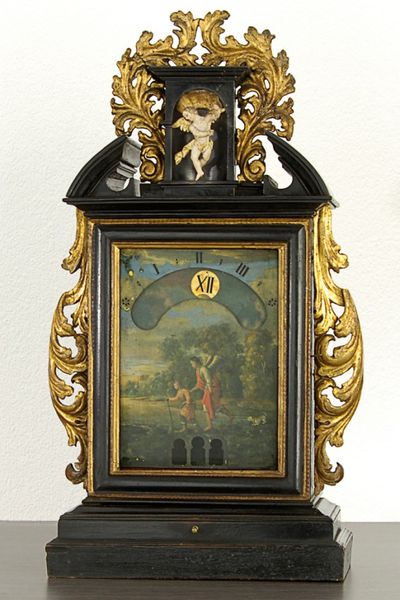Datei:Petrus Thomas Campanus Inventor Romae, 1688 (1).jpg

Originaldatei (567 × 850 Pixel, Dateigröße: 182 KB, MIME-Typ: image/jpeg)
Petrus Thomas Campanus Inventor Romae, Höhe 650 mm, 1688

|
Alle Bildrechte liegen bei dem Auktionshaus Dr. H. Crott. Diese Abbildung ist urheberrechtlich geschützt und steht nicht unter einer freien Lizenz. Für anderweitige Nutzungen außerhalb von Watch-Wiki ist die schriftliche Zustimmung des Urheberrechtsinhabers nötig. |
Historisch bedeutende Nachtlichtuhr
Geh.: ebonisiertes Obstholz, profiliert, geschnitztes und goldgefasstes Akanthus- und Volutendekor, gesprengter Giebel, Tabernakelaufsatz mit Figur eines geflügelten Putto, auf der Rückseite metallverkleideter Kamin, im Inneren Vorrichtung für die Öllampe. Ziffbl.: Kupfer, polychrom bemalt, perspektivische Landschaftsmalerei mit Schutzengel. In der oberen Hälfte bogenförmigem Ausschnitt mit runder Öffnung für drei hinterlegte, rotierende, goldene Stundenscheiben mit jeweils vier röm. Ziffern. Darüber Bogen mit ausgeschnittenen röm. Zahlen "I" bis "III" für Viertelstundenanzeige. Die Ziffern werden von einem brennenden Öllämpchen erleuchtet. Werk: rundes Messing-Vollplatinenwerk, signiert, obenliegendes Gesperr, Kette/Schnecke, Spindelhemmung, Kurzpendel.
An important and historic significance night clock Case: ebonised fruitwood, moulded, carved and gold painted acanthus leaves and volutes, broken pediment, small tabernacle with winged putto; back with metal-lined chimney and a tray for the oil lamp on the inside. Dial: copper, polychrome painted scene showing a guardian angel and a perspective landscape painting in the background. An arched cut-out in the upper half is fitted with a circular window for three rotating gold hour discs with four Roman numerals each. Above the arch are three cut-out Roman numerals I to III for the quarter hours. The numerals are illuminated up by the oil lamp inside. Movm.: round brass full plate movement, applied click work, chain/fusee, verge escapement, short pendulum.
The history of the night clock The silent night clock is one of the most important Italian contributions in the field of art and technology during the 17th century. The story behind the invention of the night clock gives us a fascinating insight into the practical considerations of one of the most important patrons in Rome during the 17th century: Pope Alexander VII (1655-1667) was unable to sleep at night because of the noise created by his clock and ordered a silent clock from the Campani brothers. The night clock had a lamp or a candle behind the open work dial which enabled the pope to read the time day and night, without ever being disturbed in his sleep. After this commission the Campanis created several more night clocks for princes, nobles, ambassadors and other members of the high clergy; the fashion for this kind of clock quickly spread through the whole of Italy and the rest of Europe. Brothers Guiseppe, Matteo and Pierre Campani designed the first night light clocks and in March 1656 presented one of them to Pope Alexander VII. However, in 1646 the Jesuit priest Atanasius Kircher in Rome had already described how to project time on a wall with an illuminated clock in his book "Ars magna lucis et umbrae" (the great science of light and shadow). The first models of the night light clocks were still fitted with verge escapements and wheel balances. The cases by the Campani brothers remind of the Italian Renaissance altars. Their shape was copied by other clockmakers and is also evident in the four remaining Knibb night light clocks in London. None of the many clocks are identical, there are always differences in the cases, movements or dials.
Dateiversionen
Klicke auf einen Zeitpunkt, um diese Version zu laden.
| Version vom | Vorschaubild | Maße | Benutzer | Kommentar | |
|---|---|---|---|---|---|
| aktuell | 21:04, 23. Okt. 2017 |  | 567 × 850 (182 KB) | Andriessen (Diskussion | Beiträge) | Petrus Thomas Campanus Inventor Romae, Höhe 650 mm, 1688 {{Bildrechte U|dem Auktionshaus Dr. H. Crott}} {{Kategorie Bildgalerie Uhrenmodelle Campani, Pietro Tommaso}} Historisch bedeutende Nachtlichtuhr Geh.: ebonisiertes Ob… |
Du kannst diese Datei nicht überschreiben.
Dateiverwendung
Die folgende Seite verwendet diese Datei:
- Bildgalerie Uhrenmodelle Campani, Pietro Tommaso
- Picture gallery watch models Campani, Pietro Tommaso
- Galería de imagenes de modelos de relojes Campani, Pietro Tommaso
- Afbeeldingen galerij uurwerkmodellen Campani, Pietro Tommaso
- Фотогалерея Модели часов Campani, Pietro Tommaso
- Galleria fotografica di modelli orologi Campani, Pietro Tommaso